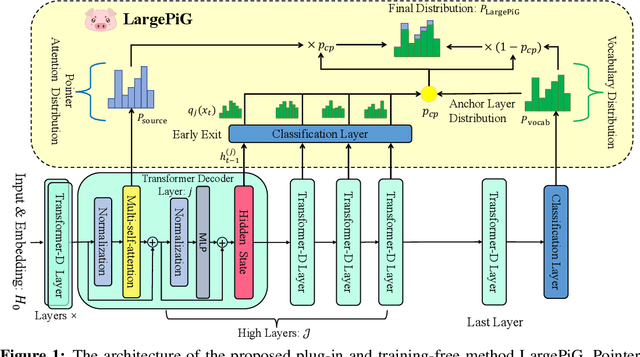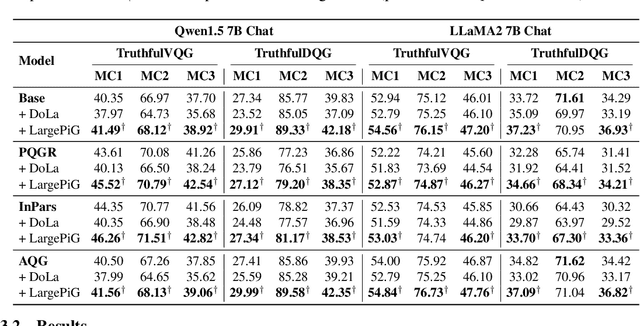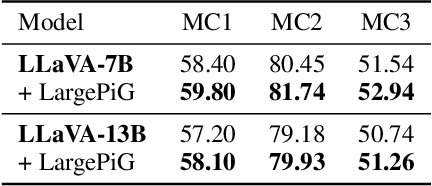Zhongxiang Sun
Detection and Mitigation of Hallucination in Large Reasoning Models: A Mechanistic Perspective
May 19, 2025Abstract:Large Reasoning Models (LRMs) have shown impressive capabilities in multi-step reasoning tasks. However, alongside these successes, a more deceptive form of model error has emerged--Reasoning Hallucination--where logically coherent but factually incorrect reasoning traces lead to persuasive yet faulty conclusions. Unlike traditional hallucinations, these errors are embedded within structured reasoning, making them more difficult to detect and potentially more harmful. In this work, we investigate reasoning hallucinations from a mechanistic perspective. We propose the Reasoning Score, which quantifies the depth of reasoning by measuring the divergence between logits obtained from projecting late layers of LRMs to the vocabulary space, effectively distinguishing shallow pattern-matching from genuine deep reasoning. Using this score, we conduct an in-depth analysis on the ReTruthQA dataset and identify two key reasoning hallucination patterns: early-stage fluctuation in reasoning depth and incorrect backtracking to flawed prior steps. These insights motivate our Reasoning Hallucination Detection (RHD) framework, which achieves state-of-the-art performance across multiple domains. To mitigate reasoning hallucinations, we further introduce GRPO-R, an enhanced reinforcement learning algorithm that incorporates step-level deep reasoning rewards via potential-based shaping. Our theoretical analysis establishes stronger generalization guarantees, and experiments demonstrate improved reasoning quality and reduced hallucination rates.
QE-RAG: A Robust Retrieval-Augmented Generation Benchmark for Query Entry Errors
Apr 05, 2025Abstract:Retriever-augmented generation (RAG) has become a widely adopted approach for enhancing the factual accuracy of large language models (LLMs). While current benchmarks evaluate the performance of RAG methods from various perspectives, they share a common assumption that user queries used for retrieval are error-free. However, in real-world interactions between users and LLMs, query entry errors such as keyboard proximity errors, visual similarity errors, and spelling errors are frequent. The impact of these errors on current RAG methods against such errors remains largely unexplored. To bridge this gap, we propose QE-RAG, the first robust RAG benchmark designed specifically to evaluate performance against query entry errors. We augment six widely used datasets by injecting three common types of query entry errors into randomly selected user queries at rates of 20\% and 40\%, simulating typical user behavior in real-world scenarios. We analyze the impact of these errors on LLM outputs and find that corrupted queries degrade model performance, which can be mitigated through query correction and training a robust retriever for retrieving relevant documents. Based on these insights, we propose a contrastive learning-based robust retriever training method and a retrieval-augmented query correction method. Extensive in-domain and cross-domain experiments reveal that: (1) state-of-the-art RAG methods including sequential, branching, and iterative methods, exhibit poor robustness to query entry errors; (2) our method significantly enhances the robustness of RAG when handling query entry errors and it's compatible with existing RAG methods, further improving their robustness.
SyLeR: A Framework for Explicit Syllogistic Legal Reasoning in Large Language Models
Apr 05, 2025Abstract:Syllogistic reasoning is a fundamental aspect of legal decision-making, enabling logical conclusions by connecting general legal principles with specific case facts. Although existing large language models (LLMs) can generate responses to legal questions, they fail to perform explicit syllogistic reasoning, often producing implicit and unstructured answers that lack explainability and trustworthiness. To address this limitation, we propose SyLeR, a novel framework that empowers LLMs to engage in explicit syllogistic legal reasoning. SyLeR integrates a tree-structured hierarchical retrieval mechanism to effectively combine relevant legal statutes and precedent cases, forming comprehensive major premises. This is followed by a two-stage fine-tuning process: supervised fine-tuning warm-up establishes a foundational understanding of syllogistic reasoning, while reinforcement learning with a structure-aware reward mechanism refines the ability of the model to generate diverse logically sound and well-structured reasoning paths. We conducted extensive experiments across various dimensions, including in-domain and cross-domain user groups (legal laypersons and practitioners), multiple languages (Chinese and French), and different LLM backbones (legal-specific and open-domain LLMs). The results show that SyLeR significantly improves response accuracy and consistently delivers explicit, explainable, and trustworthy legal reasoning.
CreAgent: Towards Long-Term Evaluation of Recommender System under Platform-Creator Information Asymmetry
Feb 11, 2025Abstract:Ensuring the long-term sustainability of recommender systems (RS) emerges as a crucial issue. Traditional offline evaluation methods for RS typically focus on immediate user feedback, such as clicks, but they often neglect the long-term impact of content creators. On real-world content platforms, creators can strategically produce and upload new items based on user feedback and preference trends. While previous studies have attempted to model creator behavior, they often overlook the role of information asymmetry. This asymmetry arises because creators primarily have access to feedback on the items they produce, while platforms possess data on the entire spectrum of user feedback. Current RS simulators, however, fail to account for this asymmetry, leading to inaccurate long-term evaluations. To address this gap, we propose CreAgent, a Large Language Model (LLM)-empowered creator simulation agent. By incorporating game theory's belief mechanism and the fast-and-slow thinking framework, CreAgent effectively simulates creator behavior under conditions of information asymmetry. Additionally, we enhance CreAgent's simulation ability by fine-tuning it using Proximal Policy Optimization (PPO). Our credibility validation experiments show that CreAgent aligns well with the behaviors between real-world platform and creator, thus improving the reliability of long-term RS evaluations. Moreover, through the simulation of RS involving CreAgents, we can explore how fairness- and diversity-aware RS algorithms contribute to better long-term performance for various stakeholders. CreAgent and the simulation platform are publicly available at https://github.com/shawnye2000/CreAgent.
ReARTeR: Retrieval-Augmented Reasoning with Trustworthy Process Rewarding
Jan 14, 2025Abstract:Retrieval-Augmented Generation (RAG) systems for Large Language Models (LLMs) hold promise in knowledge-intensive tasks but face limitations in complex multi-step reasoning. While recent methods have integrated RAG with chain-of-thought reasoning or test-time search using Process Reward Models (PRMs), these approaches encounter challenges such as a lack of explanations, bias in PRM training data, early-step bias in PRM scores, and insufficient post-training optimization of reasoning potential. To address these issues, we propose Retrieval-Augmented Reasoning through Trustworthy Process Rewarding (ReARTeR), a framework that enhances RAG systems' reasoning capabilities through post-training and test-time scaling. At test time, ReARTeR introduces Trustworthy Process Rewarding via a Process Reward Model for accurate scalar scoring and a Process Explanation Model (PEM) for generating natural language explanations, enabling step refinement. During post-training, it utilizes Monte Carlo Tree Search guided by Trustworthy Process Rewarding to collect high-quality step-level preference data, optimized through Iterative Preference Optimization. ReARTeR addresses three core challenges: (1) misalignment between PRM and PEM, tackled through off-policy preference learning; (2) bias in PRM training data, mitigated by balanced annotation methods and stronger annotations for challenging examples; and (3) early-step bias in PRM, resolved through a temporal-difference-based look-ahead search strategy. Experimental results on multi-step reasoning benchmarks demonstrate significant improvements, underscoring ReARTeR's potential to advance the reasoning capabilities of RAG systems.
Trigger$^3$: Refining Query Correction via Adaptive Model Selector
Dec 17, 2024Abstract:In search scenarios, user experience can be hindered by erroneous queries due to typos, voice errors, or knowledge gaps. Therefore, query correction is crucial for search engines. Current correction models, usually small models trained on specific data, often struggle with queries beyond their training scope or those requiring contextual understanding. While the advent of Large Language Models (LLMs) offers a potential solution, they are still limited by their pre-training data and inference cost, particularly for complex queries, making them not always effective for query correction. To tackle these, we propose Trigger$^3$, a large-small model collaboration framework that integrates the traditional correction model and LLM for query correction, capable of adaptively choosing the appropriate correction method based on the query and the correction results from the traditional correction model and LLM. Trigger$^3$ first employs a correction trigger to filter out correct queries. Incorrect queries are then corrected by the traditional correction model. If this fails, an LLM trigger is activated to call the LLM for correction. Finally, for queries that no model can correct, a fallback trigger decides to return the original query. Extensive experiments demonstrate Trigger$^3$ outperforms correction baselines while maintaining efficiency.
ReDeEP: Detecting Hallucination in Retrieval-Augmented Generation via Mechanistic Interpretability
Oct 15, 2024



Abstract:Retrieval-Augmented Generation (RAG) models are designed to incorporate external knowledge, reducing hallucinations caused by insufficient parametric (internal) knowledge. However, even with accurate and relevant retrieved content, RAG models can still produce hallucinations by generating outputs that conflict with the retrieved information. Detecting such hallucinations requires disentangling how Large Language Models (LLMs) utilize external and parametric knowledge. Current detection methods often focus on one of these mechanisms or without decoupling their intertwined effects, making accurate detection difficult. In this paper, we investigate the internal mechanisms behind hallucinations in RAG scenarios. We discover hallucinations occur when the Knowledge FFNs in LLMs overemphasize parametric knowledge in the residual stream, while Copying Heads fail to effectively retain or integrate external knowledge from retrieved content. Based on these findings, we propose ReDeEP, a novel method that detects hallucinations by decoupling LLM's utilization of external context and parametric knowledge. Our experiments show that ReDeEP significantly improves RAG hallucination detection accuracy. Additionally, we introduce AARF, which mitigates hallucinations by modulating the contributions of Knowledge FFNs and Copying Heads.
LargePiG: Your Large Language Model is Secretly a Pointer Generator
Oct 15, 2024



Abstract:Recent research on query generation has focused on using Large Language Models (LLMs), which despite bringing state-of-the-art performance, also introduce issues with hallucinations in the generated queries. In this work, we introduce relevance hallucination and factuality hallucination as a new typology for hallucination problems brought by query generation based on LLMs. We propose an effective way to separate content from form in LLM-generated queries, which preserves the factual knowledge extracted and integrated from the inputs and compiles the syntactic structure, including function words, using the powerful linguistic capabilities of the LLM. Specifically, we introduce a model-agnostic and training-free method that turns the Large Language Model into a Pointer-Generator (LargePiG), where the pointer attention distribution leverages the LLM's inherent attention weights, and the copy probability is derived from the difference between the vocabulary distribution of the model's high layers and the last layer. To validate the effectiveness of LargePiG, we constructed two datasets for assessing the hallucination problems in query generation, covering both document and video scenarios. Empirical studies on various LLMs demonstrated the superiority of LargePiG on both datasets. Additional experiments also verified that LargePiG could reduce hallucination in large vision language models and improve the accuracy of document-based question-answering and factuality evaluation tasks.
Effective In-Context Example Selection through Data Compression
May 19, 2024Abstract:In-context learning has been extensively validated in large language models. However, the mechanism and selection strategy for in-context example selection, which is a crucial ingredient in this approach, lacks systematic and in-depth research. In this paper, we propose a data compression approach to the selection of in-context examples. We introduce a two-stage method that can effectively choose relevant examples and retain sufficient information about the training dataset within the in-context examples. Our method shows a significant improvement of an average of 5.90% across five different real-world datasets using four language models.
To Search or to Recommend: Predicting Open-App Motivation with Neural Hawkes Process
Apr 04, 2024Abstract:Incorporating Search and Recommendation (S&R) services within a singular application is prevalent in online platforms, leading to a new task termed open-app motivation prediction, which aims to predict whether users initiate the application with the specific intent of information searching, or to explore recommended content for entertainment. Studies have shown that predicting users' motivation to open an app can help to improve user engagement and enhance performance in various downstream tasks. However, accurately predicting open-app motivation is not trivial, as it is influenced by user-specific factors, search queries, clicked items, as well as their temporal occurrences. Furthermore, these activities occur sequentially and exhibit intricate temporal dependencies. Inspired by the success of the Neural Hawkes Process (NHP) in modeling temporal dependencies in sequences, this paper proposes a novel neural Hawkes process model to capture the temporal dependencies between historical user browsing and querying actions. The model, referred to as Neural Hawkes Process-based Open-App Motivation prediction model (NHP-OAM), employs a hierarchical transformer and a novel intensity function to encode multiple factors, and open-app motivation prediction layer to integrate time and user-specific information for predicting users' open-app motivations. To demonstrate the superiority of our NHP-OAM model and construct a benchmark for the Open-App Motivation Prediction task, we not only extend the public S&R dataset ZhihuRec but also construct a new real-world Open-App Motivation Dataset (OAMD). Experiments on these two datasets validate NHP-OAM's superiority over baseline models. Further downstream application experiments demonstrate NHP-OAM's effectiveness in predicting users' Open-App Motivation, highlighting the immense application value of NHP-OAM.
 Add to Chrome
Add to Chrome Add to Firefox
Add to Firefox Add to Edge
Add to Edge